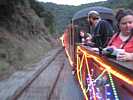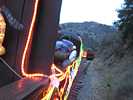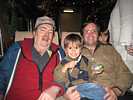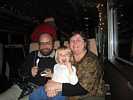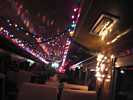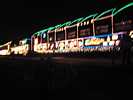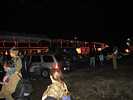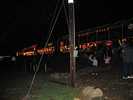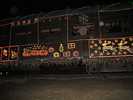|
Hey, Ed !
I MIGHT join you on the train (to help the crew if needed). In
case I'm not able to give you any sort of tour or narrative, perhaps
this email will do. Let me know BY NOON if the attached file is
somehow not printable. Attached is some USEFUL info about the cars
on the train (with various pertinent details on comfort).
| FIRST of all, you should pre-select your choices of the best cars
for your group's comfort, then when you get on board you probably
ought to 'stake out' some seats together, and not move around much
until the train gets under way. Then some of you can wander about
the train to see the sights, buy drinks, get cold, get warm again,
etc.
| 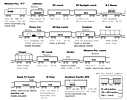
|
The modern Santa Fe coach, "Tolani", near the Niles end of the
train, is a very good place for anyone not feeling well.
For comfort in all the unheated cars (and definitely for outside
comfort) I'd advise wearing long underwear, gloves, hat and maybe
having some sort of hand-warmer device like the single-use ones sold
at OSH for about $1.50.
Boarding points for the train are chosen by the Conductor, but are
likely to include the "S.P. 2101", "All Day Lunch", "Combine",
and "W.P. 315". Sometimes they even choose the places where we
electricians installed nice halogen 'boarding lights' next to the
steps.
Incidentally, the "Combine" car still shows 3 distinct sections:
Sunol end (with the bar) has a slotted floor needed to allow drainage
of melting ice in the CARGO area. The middle section has the
pot-belly stove, a small sink, steam heat pipes, mail slots and a gun
rack for 2 shotguns used to protect the MAIL. The Niles end (which
long ago used to be walled off to protect the mail) has a small
number of seats for PASSENGERS.
Roughly 10 minutes (2 miles) into the trip the train will roll
slowly through our rail yard. You will probably pass by the
beautiful Yosemite Valley Observation car on the next track over.
Hopefully its lights will be powered by an extension cord and reveal
the many stained glass windows.
Half way through the trip, while stopped at Niles, the engineers
transfer control of the train to the new "head end" locomotive. This
mostly involves the air brake controls. You might hear radio talk
about a "20 pound reduction" (of air pressure) when one engineer sets
the brakes then disconnects his/her brake control. Then the other
engineer engages that control stand and releases the brakes. The
engineers at each end use pressure gages to verify the full
end-to-end functional connectivity of the brake line: "I see your 20
pound set". "I see your release". Much more thorough tests take
place at the rail yard when the train is first moved.
If you miss all that, you might hear if again after you arrive back
at Sunol depot.
During occasional brake use, you should be able to hear air hissing
out of high vent pipes at the ends of a few of the cars. I don't
recall which ones.
The "open" (not enclosed) cars are good for viewing the outside
lights while going around curves. Just don't lean out too far!
Might be good for a video shot.
The caboose is probably privately chartered and anyway, not safely
accessible during travel. I recommend NOT riding it even if
available because once on board it, you're there until the train
stops again. If you do go there, the absolute best place to be is up
the ladders and into the cupola where the 4 seats accommodate 8 kids
or 8 very friendly adults. I'd guess you might be forced to give up
your view seat after a few minutes. Only agile adults, wearing
proper shoes should attempt to get up there.
At various points during the trip the head end locomotive is
required by law to toot the horn. The two diesels have rather
different horn types. The "918" really bellows!
So, even without a radio, you can still know what's going on. When
the train is about to start moving: 2 short toots means 'forward',
3 short toots means 'backward'. Forward & backward are relative to
the locomotive doing the pulling, referred to as the "head end".
The morse code letter "Q" ( _ _ . _ ) is a general warning to
people and vehicles as the train approaches bridges, road crossings.
You might sometimes also hear 1 short toot which is used to
acknowledge an order from the Conductor. This is normally done the
order came by hand signal or lamp signal instead of via radio.
If anybody is carrying a portable 'scanner' radio they might enjoy
listening in on 160.695 MHz. Radio talk often includes the name
(number) of the engine. Your train will (probably) be using engine
"918" on the Sunol (east) end and engine "5623" on the Niles (west)
end. Both are beautifully restored and both have web pages to tell
their stories. (See the attachment)
PARENTS:
A big elf and his associate will be walking through the train to
excite/scare the rug-rats. Have cameras handy.
| 